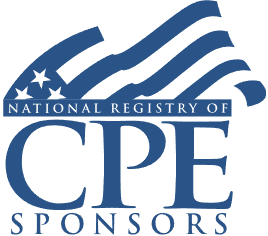Basis Calculations for Partnerships and LLCs
Book-Ups, Step-Ups, At-Risk Amounts, Allocating Liabilities, and Tax-Basis Capital Reporting

Course Details
- smart_display Format
On-Demand
- signal_cellular_alt Difficulty Level
Intermediate
- work Practice Area
Tax Preparer
- event Date
Tuesday, October 31, 2023
- schedule Time
1:00 p.m. ET./10:00 a.m. PT
- timer Program Length
110 minutes
-
BARBRI is a NASBA CPE sponsor and this 110-minute webinar is accredited for 2.0 CPE credits.
-
BARBRI is an IRS-approved continuing education provider offering certified courses for Enrolled Agents (EA) and Tax Return Preparers (RTRP).
This course will provide tax preparers and professionals advising partnerships and LLCs with a solid foundation for calculating and maintaining partners' basis accounts. The panel will discuss book-ups, step-ups, at-risk rules, the corresponding recourse and nonrecourse debt allocations, and the tax basis capital reporting requirements for Form 1065.
Faculty

Mr. Alfonsi has 25 years of tax consulting, business valuation, litigation support and forensic accounting experience. In the tax planning and consulting arena, he works primarily with partnerships and with private equity, venture capital and hedge funds.

Mr. Surkin is an attorney engaged in private practice in the New York metropolitan area. He recently retired from the position of Tax Director at a regional CPA firm based in New York City. Prior to that, Mr. Surkin was a partner at Surkin & Handlin, a boutique firm that handled real estate and tax matters. He is a tax attorney with broad-based experience in tax planning and research, has litigated major cases in the fields of taxation, probate and general commercial matters, and has been peer-reviewed by Martindale-Hubbell. Mr. Surkin holds the highest rating for legal ability and ethical standards, AV. His published articles on tax law have appeared in peer-reviewed journals, practitioners’ journals, and the popular press. Mr. Surkin also writes science-fiction short stories about the adventures of his granddaughters and their dog visiting historic events in their uncle’s time machine (their uncle is also a dog) and serves on the Board of Directors of the Westchester Community Orchestra.

Mr. Kramer has more than 14 years of client service experience, specializing in tax planning and preparation for partnerships across all industries. His primary expertise lies in advising clients on partnership formation transactions, complex allocations of profit and loss, assisting clients in complying with evolving reporting requirements, allocations of partnership liabilities, and partner exit strategies. He also advises clients on the qualified business income deduction under Section 199A and has past experience with publicly-traded partnerships, real estate investment trust operating partnerships, and renewable energy tax credits.
Description
Partnership basis account maintenance is a critical calculation for partners investing in LLCs and partnerships. It establishes the basis for deducting losses under Section 704(d). Unlike capital accounts showing deficits or negative balances, a partner's basis cannot drop below zero.
A partner's initial basis is generally equal to their initial investment in the partnership. The panel will discuss various ways partners establish their initial basis and how initial basis is computed.
When a valid Section 754 election is in place, a partnership may adjust the inside tax basis of assets when a partnership interest transfers. This can reconcile inside and outside basis differences in partnership interests but, once made, is mandatory and may require future step-downs.
Listen as our panel of experts explains tracking partnership basis, including annual income allocations, losses, tax-exempt items, step-ups, book-ups, at-risk rules, and recent tax-basis reporting requirements.
Outline
- Types of partnerships
- Annual increases and decreases to basis
- The interplay of basis and capital accounts
- Section 754 step-ups
- Book-ups
- At-risk amounts and Form 6198
- Recent tax-basis reporting requirements
- Basis issues in bankruptcy
- Best practices for tracking partners' basis
Benefits
The panel will review these and other crucial questions:
- What complexities should tax preparers be aware of when calculating the basis for pass-through entities?
- What are the increases and decreases to consider for the basis calculation?
- When should a partnership's assets be stepped up?
- What is the difference between inside and outside basis?
NASBA Details
Learning Objectives
After completing this course, you will be able to:
- Understand various annual increases and decreases to basis
- Recognize the interplay between basis and capital accounts
- Determine when a partnership's assets should be stepped up
- Differentiate inside and outside basis
- Ascertain at-risk amounts and the requirements of Form 6198
- Adopt best practices for tracking partners' basis
- Field of Study: Taxes
- Level of Knowledge: Intermediate
- Advance Preparation: None
- Teaching Method: Seminar/Lecture
- Delivery Method: Group-Internet (via computer)
- Attendance Monitoring Method: Attendance is monitored electronically via a participant's PIN and through a series of attendance verification prompts displayed throughout the program
- Prerequisite: Three years+ business or public firm experience preparing complex tax forms and schedules, supervising other preparers or accountants. Specific knowledge and understanding of pass-through taxation, including taxation of partnerships, S corporations and sole proprietorships, qualified business income, net operating losses and loss limitations; familiarity with net operating loss carry-backs, carry-forwards and carried interests.

Strafford Publications, Inc. is registered with the National Association of State Boards of Accountancy (NASBA) as a sponsor of continuing professional education on the National Registry of CPE Sponsors. State boards of Accountancy have final authority on the acceptance of individual courses for CPE Credits. Complaints regarding registered sponsons may be submitted to NASBA through its website: www.nasbaregistry.org.

Strafford is an IRS-approved continuing education provider offering certified courses for Enrolled Agents (EA) and Tax Return Preparers (RTRP).
Unlimited access to premium CLE courses:
- Annual access
- Available live and on-demand
- Best for attorneys and legal professionals
Unlimited access to premium CPE courses.:
- Annual access
- Available live and on-demand
- Best for CPAs and tax professionals
Unlimited access to premium CLE, CPE, Professional Skills and Practice-Ready courses.:
- Annual access
- Available live and on-demand
- Best for legal, accounting, and tax professionals
Unlimited access to Professional Skills and Practice-Ready courses:
- Annual access
- Available on-demand
- Best for new attorneys
Related Courses

Admitting New Partners: Tax Consequences
Friday, May 30, 2025
1:00 p.m. ET./10:00 a.m. PT

Key Issues in Succession Planning: Buy-Sell Agreements, Equity Grants, Profits Interests, Tax Considerations
Tuesday, June 17, 2025
1:00 p.m. ET./10:00 a.m. PT
Recommended Resources
How CPE Can Bridge the Gap Between What You Know and What You Need to Know
- Career Advancement